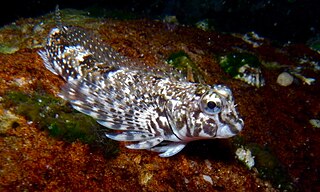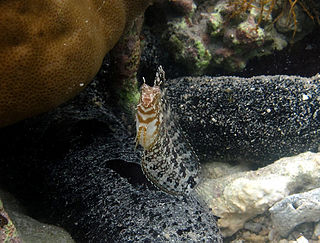
Labrisomids are small blennioids (blennies), percomorph marine fish belonging to the family Labrisomidae. Found mostly in the tropical Atlantic and Pacific Ocean, the family contains about 110 species in 15 genera.

Lepidoblennius is a genus of triplefins in the family Tripterygiidae. Both species occur in Australia.

Salarias fasciatus is a popular marine aquarium fish species in Australasia. Despite being also known as the lawnmower blenny due to its propensity to consume algae growth from rocks and glass, it is principally a detritivore, with plant material making up only 15% of its diet. This species reaches a length of 14 centimetres (5.5 in) TL. The lawnmower blenny is generally regarded as compatible with most other marine fish species and as a group with other lawnmower blennies.

Salarias is a genus of combtooth blennies found in the Indian and Pacific oceans.

Plagiotremus is a genus of blennies, in particular combtooth blennies, found throughout the Pacific and Indian oceans.
Alloblennius is a genus of combtooth blennies found in the western and northeastern Indian Ocean.

Alticus is a genus of combtooth blennies found in the Pacific and Indian oceans. It is one of 57 genera in the family Blenniidae.
Chalaroderma is a genus of combtooth blennies found in the southeast Atlantic ocean.

Chasmodes is a small genus of combtooth blennies found in the western Atlantic Ocean.

Cirripectes is a large genus of combtooth blennies found throughout the Pacific and Indian oceans.

Hypsoblennius is a genus of combtooth blennies found in the Pacific and Atlantic Oceans.
Omox is a small genus of combtooth blennies found in the western Pacific Ocean.

Petroscirtes mitratus, the floral blenny, floral fangblenny, helmeted blenny, or the crested sabretooth blenny, is a species of combtooth blenny found in coral reefs in the Pacific and Indian ocean. This species reaches a length of 8.5 centimetres (3.3 in) TL. It is the type species of the genus Petroscirtes.
Rhabdoblennius is a genus of combtooth blennies found in the Pacific Ocean, mostly in the western Pacific. The name pf this genus is derived from the Greek word rhabdos meaning "stick" or "rod" and blennius meaning "mucus", referring to the absence of scales on the body of blennies.

Gobioclinus dendriticus, the Bravo clinid, is a species of labrisomid blenny native to the Galapagos Islands and Malpelo Island. It inhabits such habitats as undercuts and ledges on rock wall faces, reefs, and areas with many boulders at depths of from 1 to 23 metres though usually no shallower than 6 metres (20 ft) and no deeper than 18 metres (59 ft). This species preys on small fishes and crustaceans. It can reach a length of 13 centimetres (5.1 in) TL.

Starksia is a genus of labrisomid blennies native to the western Atlantic Ocean and the eastern Pacific Ocean. Their typical length is 2 cm (0.79 in) SL. The generic name honours the American ichthyologist Edwin Chapin Starks (1867-1932) of Stanford University for his work on Pacific coastal fishes. As a genus Starksia is distinguished from other labrisomids by their scaled bodies, two obvious soft rays in the pelvic fin and the male's have an intromittent organ which is near to or attached to the first spine of their anal fins, which is also somewhat separated from the fin.

Gobioclinus bucciferus, the Puffcheek blenny, is a species of labrisomid blenny native to the western Atlantic Ocean and the Caribbean Sea. It can be found on reefs, seagrass beds and in algal mats along rubble or rocky shores down to a depth of 5 metres (16 ft). This species can reach a length of 9 centimetres (3.5 in) TL. This species can also be found in the aquarium trade.
Gobioclinus gobio is a strictly marine ray finned fish, also called Gobioclinus gobio. Its common name is the palehead blenny, and is sometimes referred to as the goggle-eye blenny. It can be identified by its greenish top, red belly, and multicolored banding. L. gobio is a benthic organism with a wide range, taking up residence in a number of coastal environments from Florida to Brazil. This means the fish can live in equatorial, subtropical, and tropical climatic zones. It is endemic to the West Atlantic, but not to the greater Caribbean area. Its diet consists mainly of different molluscs and echinoderms.

Lepidoblennius haplodactylus, known commonly as the eastern jumping blenny, is a species of triplefin blenny in the genus Lepidoblennius. It was described by Franz Steindachner in 1867 and is the type species of the genus Lepidoblennius.
Brockius is a genus of labrisomid from the waters of the eastern Pacific and the western Atlantic where they are associated with reefs and weed covered rocks.













